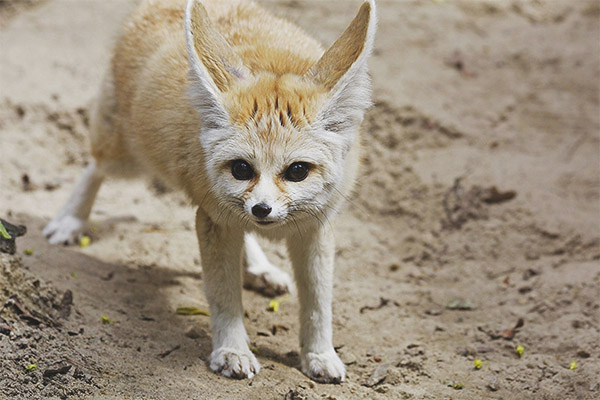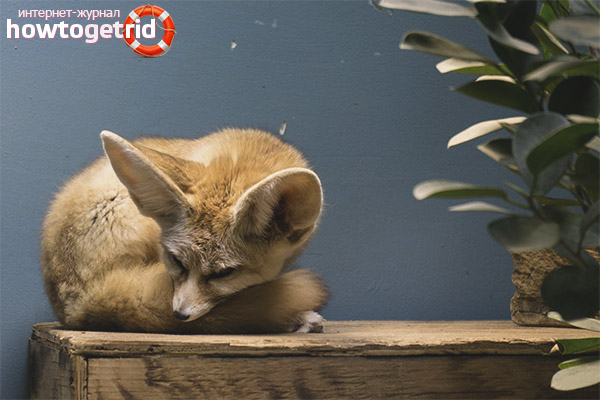The content of the article
Fenech is an extraordinary fox of small size that lives in the deserts of Africa. Is a separate species of foxes. The name of the animal originated from the Arabic word "fox". However, unlike their counterparts, Fenech is much smaller.
With its dimensions, this fox is inferior even to an ordinary domestic cat, representing itself the most compact representative of the canine family. Her height barely reaches 20 centimeters, the length of the body is about 40 cm, and the tail is no more than 30 centimeters. Body weight fenka no more than one and a half kilograms. The fox's muzzle is pointed, short, the ears and eyes are large, especially in relation to the head.
Ears can be up to 15 centimeters long! Such a large size allows the animal to hunt in the desert with high efficiency for its prey — small insects and lizards.Fox catches them using their small and sharp teeth. In addition, in extremely hot periods, the ears of the animal serve for efficient heat exchange. Fenech is predominantly a night animal, the structure of its eyes is arranged in such a way as to effectively hunt at night. In the dark, the retina of the eye casts a dark red color.
The hair of this small chanterelle is rather thick, slightly rises above the body, the color allows you to successfully hide in environmental conditions: it is red on the back and head, and the limbs and abdomen are covered with white wool. The tail is lush, its tip is painted in a dark color.
The fox dwelling in the desert is known for its dexterity, cunning, agility and ability to jump perfectly. In particular, she superbly jumps in height, reaching 70 centimeters, and the length of the jump forward is about a meter. Thus, the sacrifice that Fenech chooses to hunt is completely doomed.
Along with ordinary foxes, this animal prefers to go hunting at night, and during the day tries to find a suitable shelter in order to hide from the scorching sun. Fenek is usually hidden in cozy minks that are self-digging.For one night, the animal can dig a 6-meter hole. The network of moves and branches located underground is rather complicated and intricately arranged, having several entrances and exits at once. This helps the animal to successfully hide from its predators.
Most of these moves are created under the bushes or small desert trees, due to the roots of which the walls of minks are kept. In some cases, underground passages can be so spacious and extensive that several families can live in them without conflicts. However, usually Fenech does not worry about its own life, because in the desert conditions the animal has practically no natural enemies.
The desert fox is an omnivorous animal, therefore, it often manages to get food for itself directly from under the ground. Among the favorite food fenka present eggs of birds, small insects and lizards. Fox does not hesitate to try carrion, with pleasure will eat a variety of root vegetables. The beast is able to perfectly cope with thirst due to the liquid that can be contained in food. Often Fenech prepares food for themselves for the future.
The fox fenek is considered a social animal, they form quite numerous families, which can include about ten individuals. Often a family includes a couple of parents and two or three generations of cubs. Then, as the offspring grows older, the large family breaks up into several. They communicate among themselves fenki, using a specific set of sounds.
Habitat fenka
Fox tries to live in hot desert areas, adhering to a few thickets of dry shrubs and grass. Thus, it is very important for an animal to live where there is vegetation. It is there that she can spend her holidays, shelter from the hot sun and rare predatory animals.
This animal tries not to approach human settlements, does not contact with people and keeps away from water. If people and dwellings appear near the underground holes and shelters of fescue, soon a fox will leave this area.There is currently no verified information on the number of Fenek fox in the deserts. Often they are killed by hunters who want to get the beautiful fur of the animal, sometimes they also catch the fox in order to be sent to pet stores in the future.
Peculiarities of reproduction and lifespan

Desert fox produces offspring once a year. The only exceptions are those cases in which the first calves die. Then the female gives birth to second cubs in one year. With the onset of January, the marriage ritual of animals begins. However, the heat of the female lasts no more than two days. These animals are monogamous, so couples form with them for a long time.
Male and female choose for themselves a specific territory of a desert area, securing it for themselves. For several dozen days, during which the marriage ritual is performed, the males show anxiety, militancy and aggression, actively mark the area around the dwelling with their own urine. Meanwhile, the female is taken to signal intensively ο readiness for mating, moving its tail to the side.
Before being born, babies are bred for a couple of months. In springtime 4-6 puppies are born. It occurs in a small mink filled with down of birds, dry vegetation and fur. The little ones are born absolutely unadapted to independent existence, they are blind and helpless. Their weight barely reaches fifty grams, the body is covered with short and sparse fluff, the color is close to cream. After 13-15 days the eyes of the kids open. The ears, which when folded into the world, are collapsed, at the same moment become upright. Their growth occurs rather quickly and will soon look like in adult animals.
During the first couple of weeks, the female does not leave the “nursery”, is always near her own young, not allowing even a male to come to them. The role of the latter is in the extraction of food, which he brings to the mink, but he does not even look inside. Otherwise, he has the risk of running into the aggression of the female.
About a month after the birth, the puppies begin to leave their burrows, exploring the surrounding area. However, at first they do not leave home for a long time and do not go too far.Only by three months, when the mother stops feeding them with her own milk, can they decide to move far enough away from the foxhole for a long time.
When he is 9 months old, he is an adult, mature animal that can mate and survive in difficult desert conditions. Often by this time Fenech leaves his family in order to create their own.
However, sometimes the animal stays with its parents. They are also engaged in the continuation of their own kind, increase the number of clans and assist in raising a new offspring. Under natural conditions, the life span of a desert fox is not very long, reaching about 6-7 years. However, with the maintenance of fenka in an apartment or a comfortable aviary, an animal can live a couple of decades.
The maintenance of gadget in the house
There is no great difficulty in keeping an animal in an apartment and breeding it. They calmly and easily adapt to unusual environments and multiply superbly. Being a pet, this little fox will become a gentle, attentive and intelligent pet, especially if you take the time to properly educate it.However, overly relaxing is not recommended, as any animal needs to be caring and sensitive.
For the maintenance of gadget in the apartment, you must have a spacious cell or even a small room, which will become a personal dwelling for the pet, despite its small size. The floor in the fox cage will need to be covered with a thick sand layer where the animal will be able to dig for itself mink. This fox has a real need for this; otherwise, Fenech will attempt to dig a shelter for himself completely differently where necessary.
It may be difficult to train a fox to go to the toilet in the same place. Thus, the room chosen for living of a pet should imply the ability to relieve the need anywhere. If the fox has no such opportunity, then an unpleasant smell will instantly spread throughout the house.
When keeping a fox in the house, there are usually no problems with feeding the animal. He is quite unpretentious, omnivorous, can eat almost everything that will be given to him. But it should be understood that first of all the fox is a predatory animal, therefore it is necessary to focus on food of animal origin.Fenka does not have to constantly have water to drink, but to completely forget about it is not advised.
The diet can be made from meat pieces or live food - small insects, mice and lizards. Fox will be happy to hunt them. It is not prohibited to supplement the feed with eggs, fish or dairy products. Sometimes you can offer your pet delicious porridge. You can quickly figure out what kind of food your favorite prefers.
The cost of fenka
To acquire such a specific pet for yourself, you will need to have a sufficiently large amount of money. The cost of an overseas animal usually exceeds the amount of 35 000 rubles. In addition, maintaining a desert fox at home incurs a considerable amount of costs.
An animal must be provided with all conditions that are as close as possible to its natural habitat.Pet should be warm, comfortable, in the aviary or room should be sand and constant food. It is forbidden to keep the animal on a cool balcony or in a room that is regularly ventilated.
Video: Fenech (Vulpes zerda)












To send